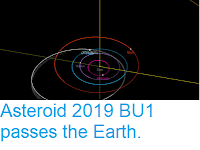Asteroid 2019 AV2 passed by the Earth at a distance of about 6 723 000
km (17.5 times the average distance between the Earth and the Moon, or 4.49% of the distance between the Earth and the Sun), slightly after 8.30 pm
GMT on Friday 1 February 2019. There was no danger of
the asteroid hitting us, though were it to do so it would have
presented a significant threat. 2019 AV2 has an estimated
equivalent
diameter of 110-340 m (i.e. it is estimated that a spherical object
with
the same volume would be 110-340 m in diameter), and an object of this size would be predicted to be capable of
passing through the Earth's
atmosphere relatively intact, impacting the ground directly with an
explosion that would be between about 600 and 100 000 times as powerful as the
Hiroshima
bomb. Such an impact would result in an impact crater between 1.5 and 5.0 km
in
diameter
and devastation on a global scale, as well as climatic effects that
would last years or even decades.
The calculated orbit of 2019 AV2. JPL Small Body Database.
2019 AV2 was discovered on 3 January 2018 (28 days before its closest approach to the Earth) by the Atlas MLO Telescope at Mauna Loa Observatory in Hawaii. The designation 2019 AV2
implies that the asteroid was the 69th object (object V2 -
in numbering asteroids the letters A-Y, excluding I, are assigned
numbers from 1 to 24, so that V2 = (24 x 2) + 21 = 69) discovered in the first half of January 2019 (period 2019 A).
2019 AV2 has an 1412 day orbital period and an eccentric orbit
tilted at an angle of 9.01° to the plane of the Solar System, which
takes it from 0.87 AU from the Sun (i.e. 87% of the the average distance
at
which the Earth orbits the Sun) to 4.05 AU from the Sun (i.e. 4.05% of
the
average distance at which the Earth orbits the Sun, more than twice the distance at
which Mars orbits). It is therefore
classed as an
Apollo Group Asteroid (an asteroid that is on average further from the
Sun than the Earth, but which does get closer). This means that close
encounters between the asteroid and Earth are extremely common, with the
last having occurred in June 2014 and the next predicted
in June 2042. 2019 AV2 also has occasional close encounter with the
planet Jupiter, with the last having happened in August 1986 and the next predicted for September 2105. As an
asteroid probably larger than 150 m in diameter
that occasionally comes within 0.05 AU of the Earth, 2019 AV2 is also
classified as a Potentially Hazardous Asteroid.
See also...
See also...
Follow Sciency Thoughts on Facebook.







